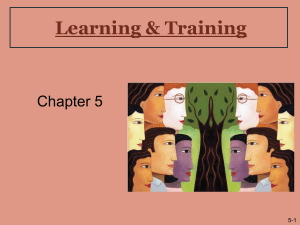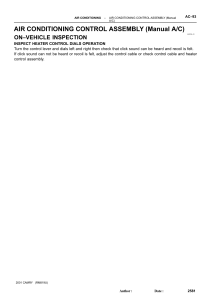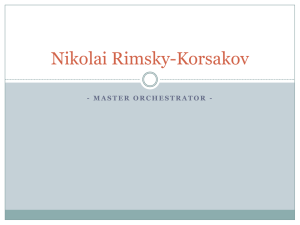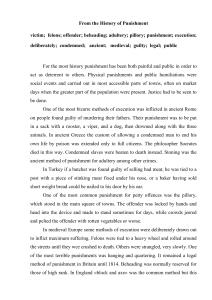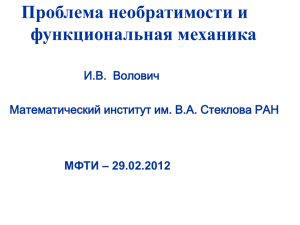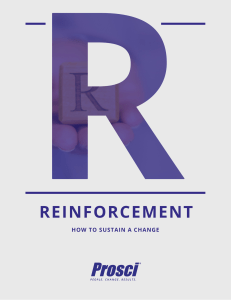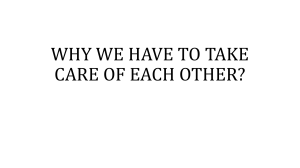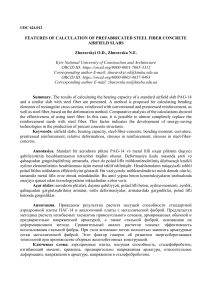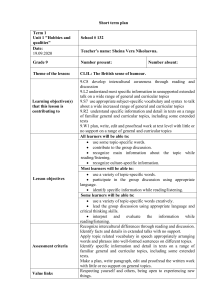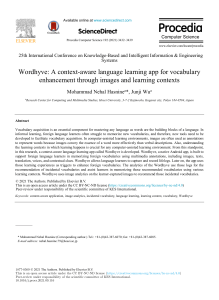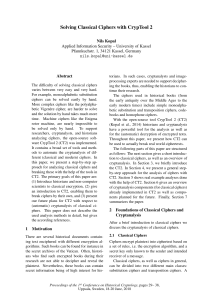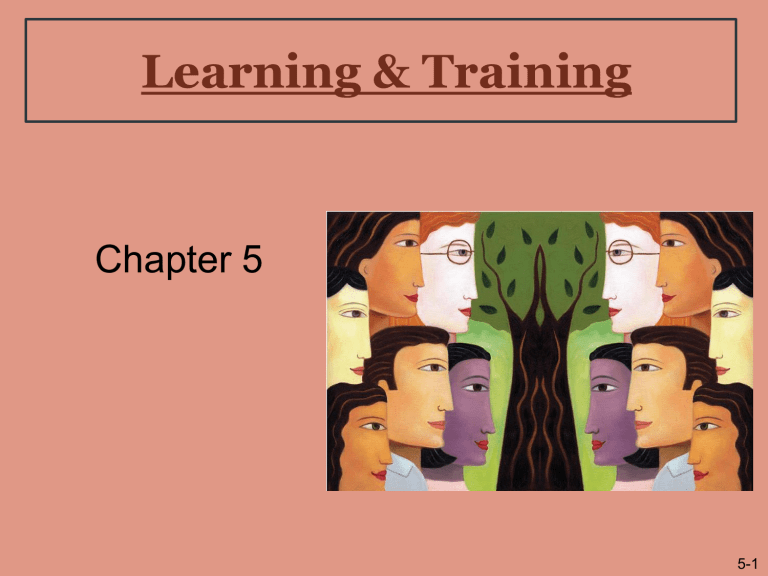
Learning & Training Chapter 5 5-1 Before Starting What happens to your life? Any little changes in you? - Thinking - Feeling - Behavior What did we study in Chap. 4? 2 Key words of Chap. 4 3 Lessons of Chap. 5 Lesson 1: Classical Conditioning Theory Lesson 2: Operant Conditioning Theory Lesson 3: Social Cognitive Theory 4 We are studying OB 5 Lesson 1 Classical Conditioning Theory 6 Two Kinds of Behaviors Instinctive (unlearned) Behavior Learned 5-7 Learned Behaviors Eating Cooked Three times a day With chopsticks (Korean) Communicating Thru languages Thru letters Conversation, Speech Teleconferencing 5-8 Early Learning Learning in Childhood 5-9 Professional Learning Knowledge Skills Attitude Values 5-10 Learning in Organization Learning becomes more important! Why? 5-11 Professional Obsolescence Skill Level (Usefulness) Time (Age) 5-12 Lifelong Learning Continuing Education Learning Person (Homo Eruditio) Learning Organization Learning Society 5-13 Learning Defined Learning is a relatively permanent change in knowledge or behavior that results from practice or experience With learning comes change Change must be relatively permanent Learning takes place as a result of practice or through experience 5-14 Three Major Learning Theories 1. Classical Conditioning Theory 2. Operant Conditioning Theory 3. Social Cognitive Theory 5-15 Classical Conditioning Classical conditioning (also known as Pavlovian or respondent conditioning) refers to a learning procedure in which a biologically potent stimulus (e.g. food) is paired with a previously neutral stimulus (e.g. a bell). Ivan Pavlov(1849-1936) 5-16 Classical Conditioning 5-17 Classical Conditioning Classical conditioning (also known as Pavlovian or respondent conditioning) refers to a learning procedure in which a biologically potent stimulus (e.g. food) is paired with a previously neutral stimulus (e.g. a bell). Ivan Pavlov(1849-1936) 5-18 Classical Conditioning Stimulus (food, unconditioned) Response (Salivation, physiological) Stimulus (Bell, conditioned) 5-19 Higher-Order Conditioning Food Salivation Bell Person in white gown Step sound of person 5-20 Classical Conditioning in Org’n Most emotional response of employees (Higher-order Conditioning) Anxious response to the boss or customers Joyful reactions to a sound, smell, or color (Without awareness of employee) 5-21 Classical Conditioning for Self-Control Anchoring: It usually involves a touch, gesture or word as an ‘anchor’, like a bookmark for a desired emotion, and recall it again later using the same anchor. (NLP technique) Baseball Batter Hit a homerun Good feeling (Being confident) Hit the chest 5-22 Exercise for lesson 1 1. What is learning? 2. Why is learning becoming more important in today’s society? 3. What are three major learning theories? 4. What is conditioning? 5. What is anchoring? 23 Lesson 2 Operant Conditioning Theory 24 Operant Conditioning Operant conditioning describes how learning takes place when the learner recognizes the connection between a behavior and its consequences(reinforcement) Burrhus Frederic Skinner(1904-1990) 5-25 Dog Training 5-26 Operant vs. Classical Conditioning What are the differences between Pavlovian experiment and dog training? 5-27 Two Conditioning Theories Classical Stimulus (food, unconditioned) Response (salivation, physiological) Stimulus (bell, conditioned) Operant Stimulus (order, conditioned) Response (Stay, Operant Behavior) Stimulus (reward, unconditioned) 5-28 Operant Conditioning Simply put, operant conditioning refers to a systematic program of rewards and punishments. 5-29 Operant Conditioning 5-30 Reinforcement in Operant Conditioning The process by which the probability that a desired behavior will occur is increased by applying consequences that depend on the behavior in question Step 1: Identify desired behaviors to be encouraged Step 2: Decide how to reinforce the behavior 5-31 Learning Desired Behaviors Positive Reinforcement Negative Reinforcement 5-32 Positive Reinforcement Administering positive consequences to employees who perform the behavior. Pay Bonus Promotion Job title Verbal praise Award 5-33 Negative Reinforcement Removing negative consequences when employees perform the desired behaviors. When Bob does the dishes, mom stops nagging. Play hard to avoid cut-off Save money to prevent bankruptcy Keep social distance to prevent infection 5-34 Reinforcement Schedules • Continuous • Partial Fixed-interval Variable-interval Fixed-ratio Variable-ratio 5-35 Shaping Shaping is the reinforcement of successive and closer approximations to a desired behavior Powerful for complicated sequences Gradual acquisition of skills 5-36 Operant Conditioning 5-37 Discouraging Undesired Behaviors Extinction Punishment (negative punishment) (positive punishment) Remove existing rewards - Attention given to misbehavior - Extra-hour pay to lazy person - Reward to aggressive behavior 5-38 Organizational Behavior Modification Organizational behavior modification (OB MOD) is the systematic application of the principles of operant conditioning for teaching and managing organizational behavior 5-39 The Basic Steps of OB Mod • Identify the behavior to be learned • Measure the frequency of the behavior • Analyze antecedents and consequences • Intervene • Evaluate the performance improvement 5-40 Steps in OB Mod Identify important organizational behavior Measure the frequency of the behavior Analyze antecedents and consequences Intervene Evaluate for performance improvement Problem solved? No Yes Maintain 5-41 Application of Operant Conditioning Simply put, operant conditioning refers to a systematic program of rewards and punishment. 1. Focus on specific behaviors, not the person. 2. Encourage desired behaviors before discouraging undesired ones. 3. Maximize rewards and minimize punishment 4. When use punishment, be impersonal. 5-42 Exercise for lesson 2 1. How is operant conditioning different from classical conditioning? 2. What is positive reinforcement? What is negative reinforcement? 3. What is extinction? 4. What’s the process of behavioral modification in organization? 5. What are general rules for the application of operant conditioning? 43 Lesson 3 Social Cognitive Learning Theories 44 Social Cognitive Theory Do you like conditioning theories? What would be the major problems? Learning happens without reinforcement! Albert Bandura(1925 - ) Bobo Doll Experiment 5-45 Bobo Doll Experiment 5-46 Social Cognitive Theory A learning theory that takes into account the fact that thoughts and feelings influence learning Necessary components include Vicarious learning Self-control Self-efficacy 5-47 Social Cognitive Theory Information Learner Vicarious Learning Self-Control Behavior Self-Efficacy 5-48 Vicarious(Observational) Learning Learning that occurs when one person (the learner) learns a behavior by watching another person (the model) perform the behavior Examples Role playing Demonstrations Training films Shadowing 5-49 Vicarious Learning Physicians learn vicariously by watching skilled physicians treat patients What are your experiences? 5-50 Conditions Required for Vicarious Learning • Learner observes the model when the model is performing the behavior • Learner accurately perceives model’s behavior • Learner must remember the behavior • Learner must have the skills and abilities to perform the behavior • Learner must see that the model receive reinforcement for the behavior in question 5-51 Mentoring Program • Mentoring programs connect people who have specific skills and knowledge (mentors) with individuals (protégés or mentee) who need or want the same skills and advantages to move up in work, skill level, or school performance. • Mentor is usually not the superior. • Mentoring for specific purposes • Mentoring for general coaching 5-52 Use of Self-Control • Learner sets goals for learning • Learner makes plan for learning • Learner uses self-reinforcement and self- punishment • Self-control in low-probability behavior 5-53 Use of Self-reinforcement • What rewards do you give to yourself, when you do well? • What punishments do you give, when you do badly? 5-54 Self-Efficacy Self-efficacy is a person’s belief about his or her ability to perform a particular behavior successfully 5-55 Sources of Self-Efficacy • Past performance • Vicarious experience • Verbal persuasion • Individuals’ readings of their internal physiological states 5-56 Learning by Doing Experiential learning Direct involvement in subject matter Hands-on training 5-57 Application of Social Cognitive Theory 1. People must be involved in their learning. 2. Learning must be integrated into the life of people in the workplace. (formal learning+informal learning) 3. Encourage social communication and connection between people. 4. Learning must be open and flexible. 5-58 The Learning Organization Organizational Learning Knowledge Management 5-59 Central Activities in a Learning Organization • Encouragement of personal mastery or high self- efficacy • Development of complex schemas to understand work activities • Encouragement of learning in groups and teams • Communication of a shared vision for the organization as a whole • Encouragement of systematic thinking 5-60 Chapter Review 1. Close your book and notes. 2. Take a blank sheet and try to write down on the sheet the key words you’ve learnt today, as many as possible, without any reference.(2 min.) 3. Now, look at your notes and lecture slides of today’s class. (3 min.) 4. Select three key words you’d like to memorize from today’s lessons. Thank You Very Much!
